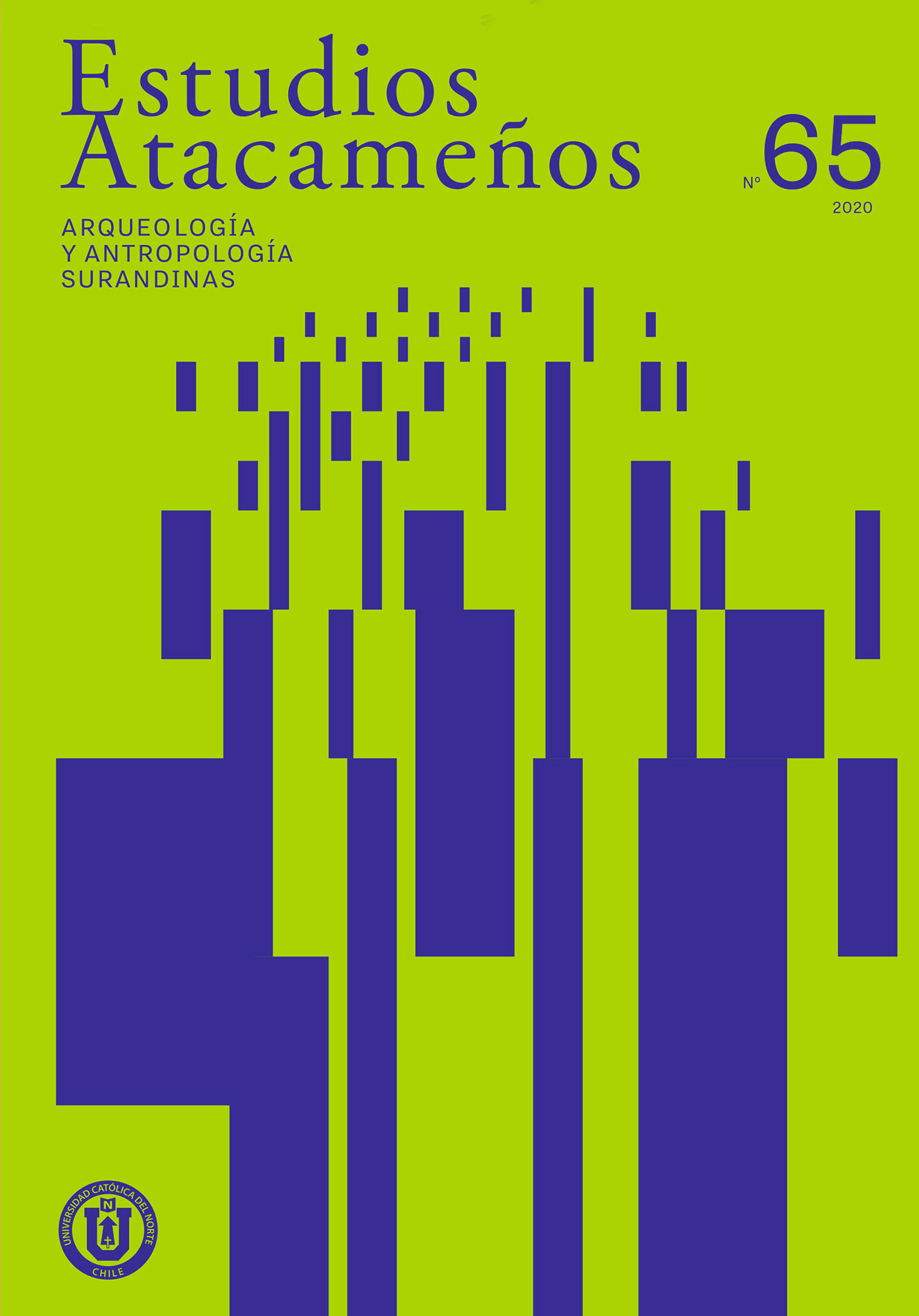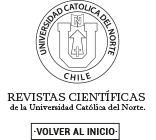Traditional whaling operations on the South American Shores
Characteristics, transformations and continuities
DOI:
https://doi.org/10.22199/issn.0718-1043-2020-0020Keywords:
traditional whaling, basque tradition, yankee tradition, South American whaling operationsAbstract
Historians distinguish two major categories in commercial whaling, with a technological regime specific: traditional and modern whaling. The use of vessels, open boats, manual harpoons and spears defines traditional whaling, and modern whaling by the presence of whale catchers armed with an explosive harpoon gun mounted on its bow. In traditional whaling, two varieties, "Basque" and "Yankee", which come in South America at different times, operates on pre-existing knowledge and practices (processing of whales and/or hunting properly) in the local coastal communities. The presence of foreign whalers makes it possible to explain the emergence of local operations in Brazil, Chile and Peru, which successfully integrates technological, social and productive elements of the visiting groups with their own in a complex set of transformations and continuities, constituting "local whaling traditions". Our studies have been focused on the Chilean case, but the literature tell us if the Brazilian and Peruvian experiences are "different" or "similar" to the Chilean experiences, considering their exposure to foreign influences. Traditional Atlantic and Pacific whaling operations show a lot of technological similarities but some organizational differences, especially in terms of the relevance of private initiative and the role of the State.
Downloads
References
Referencias citadas
Aguilar, A. (1986). A Review of Old Basque Whaling and its Effect on the Right Whales (Eubalaena glacialis) of the North Atlantic. Report of International Whaling Commission, Special Issue, 10, 191-199.
Aguilar, A. (2013). Chimán. La pesca ballenera moderna en la provincia ibérica. Barcelona: Universitat de Barcelona.
Basberg, B. (1998). The ?oating factory: dominant designs and technological development of twentieth century whaling factory ships. The Northern Mariner, 8(1), 21-37.
Basberg, B. (2004). The shore whaling stations at South Georgia: a study in Antarctic industrial archaeology. Oslo: Novus Forlag.
Bezerra, A. S. (2015). Arquivo e memória oral na produção de uma ‘etnografia retrospectiva’. ANTROPOlógicas, 13, 67-78.
Brown, S. G. (1976). Modern whaling in Britain and the north-east Atlantic Ocean. Mammal Review, 6(1), 25-36.
Cartes, A. (2009). Los cazadores de Mocha Dick. Balleneros chilenos y norteamericanos en el sur del océano de Chile. Santiago: Pehuén.
Castellucci Junior, W. (2009). Caçadores de baleia: armações, arpoadores, atravessadores e outros sujeitos envolvidos nos negócios do cetáceo no Brasil. São Paulo: Annablume.
Castillo, L. (1906). La pesca de la ballena en la isla Santa María. Santiago: Cervantes.
Cavieres, E. (1999). Comercio chileno y comerciantes ingleses, 1820-1880. Santiago: Universitaria.
Cédula de S. M. para el establecimiento de la Real Compañía Marítima (1789). Madrid: Imprenta Real.
Clapham, P. J. y Baker, C. S. (2009). Modern whaling. En Perrin, W. F., Würsig, B. y Thewissen, J. G. M. (Eds.). Encyclopedia of Marine Mammals (pp. 1239-1243). New York: Academic Press.
Coker, R. (1908). Las ballenas del Perú. Boletín del Ministerio de Fomento, VI (5),115-125.
Davis, L. E., Gallman, R. E. y Gleiter, K. (1997). In pursuit of Leviathan: technology, institutions, productivity and profits in american whaling, 1816–1906. Chicago, IL: The University of Chicago Press.
Denegri, F. (1997). Historia Marítima del Perú, La Repu?blica: 1826 a1851. Conflicto Peruano-Ecuatoriano 1858-1859. Tomo VI, volumen 2. Lima: Instituto de Estudios Histórico-Marítimos del Perú.
Dolin, E. J. (2007). Leviathan. The history of whaling in America. New York: W.W. Norton & Co.
Donovan, G. P. (1982). The International Whaling Commission and Aboriginal Subsistence Whaling: April 1979 to July 1981. Report of the International Whaling Commission, 4, 79-86.
Driessen, H. G. G. M. (2013). Suspense in Retrospective Ethnography. En Pelkmans, M. E. (Ed.). Ethnographies of Doubt: Faith and Uncertainty in Contemporary Society (pp. 149-164). Londres: I. B. Tauris.
Du Pasquier, T. (2000). Les baleiniers basques. París: Editions S.P.M.
Dublé Urrutia, D. (1905, febrero 7). Tumbes (V). La caza de la ballena. El Sur [Concepción], pp. 1, 5.
Edmundson, W. y Hart, I. (2014). A história da caça das baleias no Brasil: do peixe real a iguaria japonesa. São Paulo: DISAL.
Ellis, M. (1969). A baleia no Brasil colonial. Sao Paulo: Melhoramentos.
Ellis, R. (2009). Traditional whaling. En Perrin, W. F., Würsig, B. y Thewissen , J. G. M. (Eds.). Encyclopedia of Marine Mammals (pp. 1243-1254). New York: Academic Press.
El Mercurio de Valparaíso, 1871 (diciembre 14).
El Mercurio de Valparaíso, 1872 (julio 6).
Fernández, A. (1964). La caleta y su gente: Tumbes, estudio etnográfico (Memoria para optar al título de Profesor de Estado). Universidad de Concepción, Concepción.
Flores, R. (2010). Los balleneros anglo-norteamericanos y la apertura comercial del Pacífico sur a fines de la época colonial (1790-1820). Historia, XXXIV(2), 63-98.
Flores, R. (2011). Los balleneros anglo-estadounidenses y la cuestión de la ‘extranjerización’ del comercio peruano a fines de la época colonial, 1790-1820. América Latina en la Historia Económica, 36, 39-64.
Freeman, M. M. R. (1993). The International Whaling Commission, Small-Type Whaling, and Coming to Terms with Subsistence. Human Organization, 52(3), 243-25.
Gil, G. (2010). Etnografía, archivos y expertos. Apuntes para un estudio antropológico del pasado reciente. Revista Colombiana de Antropología, 46(2), 249-278.
Gonçalvez, R. De Sá (2009). Sociabilidades urbanas: cronistas e ranchos carnavalescos no Rio de Janeiro. En Gonçalves, J. R. S. y De C. Cavalcanti, M. L. V. (Eds.). As festas e os dias: ritos e sociabilidades festivas (pp.77-93). Rio de Janeiro: Contracapa.
Hacquebord, L. (2003). English and Dutch Whaling Trade and Whaling Stations in Spitsbergen (Svalvard) before 1660. International Journal of Maritime History, 15, 117-134.
Hacquebord, L. (2010). English and Dutch whaling stations in Spitsbergen (Svalbard) in the 17th Century. En Ringstad , J. E. (Ed.). Whaling and History III (pp. 59-68). Sandefjord: Kommandør Chr. Christensens Hvalfangst Museum.
Harvey, D. (2014). Seventeen Contradictions and the end of Capitalism. Londres: Profile Books.
Heazle, M. (2006). Scientific Uncertainty and the Politics of Whaling. Seattle: University of Washington Press.
Hernández, J. (1998). Dónde viven las ballenas. Actividades balleneras en la isla Santa María y Chome del pionero Juan Macaya Aravena. Concepción: Aníbal Pinto.
Higham, J. E. S. y Neves, K. (2015). Whales, tourism and manifold capitalist fixes: New relationships with the driving force of capitalism. En Markwell, K. (Ed.). Tourism and Animals: Understanding Diverse Relationships (pp. 109-126). Bristol: Channel View Publications.
Kalland, A. y Moeran B. (1992). Japanese whaling: end of an era? London: Curzon Press.
Kasuya, T. (2009). Japanese whaling. En Perrin, W. F., Würsig, B. y Thewissen, J. G. M. (Eds.). Encyclopedia of Marine Mammals (pp. 643–649). Nueva York: Academic Press.
La Tarántula. Concepción, 1869 (marzo 1).
Lennartsson, R. (2011). Notes on ‘not being there’. Ethnographic Excursions in Eighteenth-Century Stockholm. Ethnologia Europea, 41(1), 105-116.
Lindquist, O. (1994). Whales, dolphins and porpoises in the economy and culture of peasant fishermen in Norway, Orkney, Shetland, Faroe Islands and Iceland, ca. 900-1900 A.D., and Norse Greenland, ca.1000-1500 A. D. (Thesis for the Degree of Doctor of Philosophy). Saint Andrews, University of St Andrews, Escocia.
Lofstrom, W. L. (1996). Paita, Outpost of Empire. Mystic: Mystic Seaport Museum.
Marcus, G. (2001). Etnografía en/del sistema mundo. El surgimiento de la etnografía multilocal. Alteridades, 11, 111-127.
Martínez Shaw, C. (2008). Economía e imperio. Los establecimientos de la Real Compañía Marítima en América. Anuario de Estudios Atlánticos, 54(1), 593-630.
Melo, R. (1915). Historia de la Marina del Perú, III (Navegación Fluvial). Boletín de la Sociedad Geográfica de Lima, XXXI(I), 51-74.
Meseldzic, Z. (1985). Yugoslavos en el Perú. Lima: La Equidad.
Moeran, B. (1992). The Cultural Construction of Value, ‘Subsistence’, ‘Commercial’ and Other Terms in the Debate about Whaling. Maritime Anthropological Studies, 5(2), 1-15.
Montalbán, C. y Capdevila, R. (2013). Los puertos del Plata en la ruta antártica durante la “época heroica”. Boletín del Centro Naval (Montevideo), 835, 99-110.
Montiel, F. (2010). Chiloé, historias de viajeros. Castro: Masterprint.
Palacio Rodríguez, R. (1991). Historia Marítima del Perú. La República: 1884 a 1906. Tomo XII, volumen 2. Lima: Instituto de Estudios Histórico-Marítimos del Perú.
Pereira Salas, E. (1971). Los primeros contactos entre Chile y los Estados Unidos, 1778–1809. Santiago: Andrés Bello.
Pozzi, C. (1875). Memoria del Gobernador Marítimo de Talcahuano. En Memoria que el Ministerio de Marina presenta al Congreso Naciona1 (pp. 269-282). Santiago: Imprenta Nacional.
Proulx, J. P. (1986). Whaling in the North Atlantic from Earliest Times to the Mid- 19th Century. Ottawa: National Historic Parks and Sites Branch Parks Canada.
Puga, J. (1885). De la pesca i de la caza en Chile. Boletín de la Sociedad de Fomento Fabril, 2, 365-381.
Quiroz, D. (2012). Cazadores tradicionales de ballenas en las costas de Chile (1850–1950). Santiago: Centro de Documentación de Bienes Patrimoniales.
Quiroz, D. (2015). Balleneros en la niebla: una mirada para-etnográfica de la caza de ballenas en Chile. Chungara. Revista de Antropología Chilena, 47(2), 319-330.
Quiroz, D. (2016). Excursiones etnográficas entre los pescadores de ballenas de Tumbes y la isla Santa María, Chile, a comienzos del siglo XX. Antropologías del Sur, 5, 103-123.
Reeves, R. R. (2002). The origins and character of ‘aboriginal subsistence’ whaling: a global review. Mammal Review, 32(2), 71-106.
Reeves, R. R. y Smith, T. D. (2006). A Taxonomy of World Whaling: Operations, Eras, and Data Sources. En Estes, J. A., DeMaster, D. P., Doak, D. F., Williams, T. M. y Brownell Jr., R. L. (Eds.). Whales, Whaling and Ecosystems (pp. 82-101). Berkeley: University of California Press.
Robbins, J. S. (1996). How Capitalism Saved the Whales. En Folson, C. W. (Ed.). The Industrial Revolution and the Free Trade (pp. 75-79). Irvington, NY: The Foundation for Economic Education Inc.
Sandoval, A. (1978). Talcahuano y los últimos balleneros a vela. Revista de Marina, 89(3), 233-235.
Shoemaker, N. (2014). Living with whales. Amherst, MA: University of Massachusetts Press.
Schokkenbroek, J. (2008). Trying-out. An anatomy of Dutch whaling and sealing in the nineteenth century, 1815–1885. Amsterdam: Aksant.
Silva, H. (1978). La economía pesquera en el Virreinato del Río de la Plata. Buenos Aires: Fundación para la Educación de la Ciencia y la Cultura.
Smith, T. D., Reeves, R. R., Josephson, E. A. y Lund, J. N. (2012). Spatial and seasonal distribution of American whaling and whales in the age of sail. PLoS One, 7(4), e34905.
Sotomayor, R. (1854). Informe del Intendente de Concepción en contestación a la Circular del 6 de marzo de 1854. En Memoria del Ministerio de Marina (pp. 50-58). Santiago: Imprenta de Julio Belin.
Takahashi, J. (1998). English Dominance in Whaling Debates A Critical Analysis of Discourse at the International Whaling Commission. Japan Review, 10, 237-253.
Takahashi, J., Kalland, A., Moeran, B. y Bestor, T. C. (1989). Japanese Whaling Culture: Continuities and Diversities. Maritime Anthropological Studies, 2(2), 105-133.
Tato, S. (1985). Hogei no rekishi to shiryo [Historia y estadísticas balleneras]. T?ky?: Suisansha.
Thomas, K. (2009). The Ends of Life. Oxford: Oxford University Press.
Tilly, C. (1978). Anthropology, History and the ‘Annales’. Review, 1(3/4), 207-213.
Tønnesen, J. N. y Johnsen, A. O. (1982). The History of Modern Whaling. Berkeley and Los Angeles, CA: University of California Press.
Van Ginkel, R. (2007). Coastal Cultures: An Anthropology of Fishing and Whaling Traditions. Apeldoorn: Het Spinhuis.
Downloads
Published
Issue
Section
License
Copyright (c) 2020 Estudios Atacameños. Arqueología y antropología surandinas

This work is licensed under a Creative Commons Attribution 4.0 International License.

All works published in Revista Estudios Atacameños (ISSN on line:0718-1043) Revista Estudios Atacameños Creative Commons International 4.0 attribution (CC BY 4.0) licence.
Authors remain the owners of their work and may republish their articles elsewhere without having to request permission, as long as they indicate that the work was originally published in Revista Estudios Atacameños (ISSN on liine:0718-1043).












